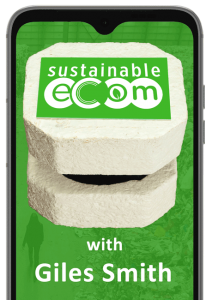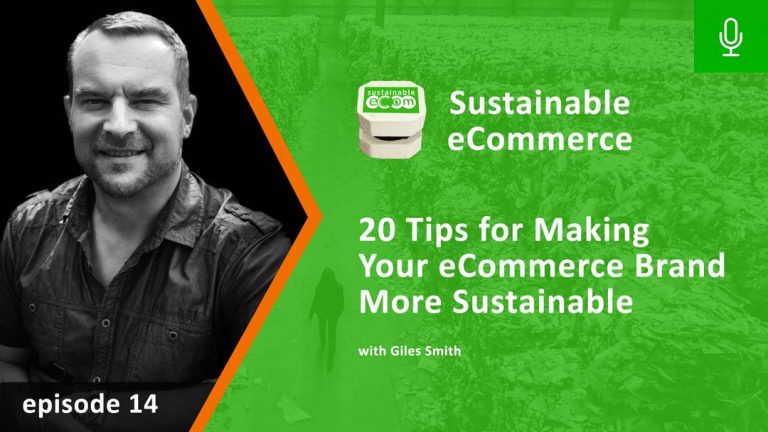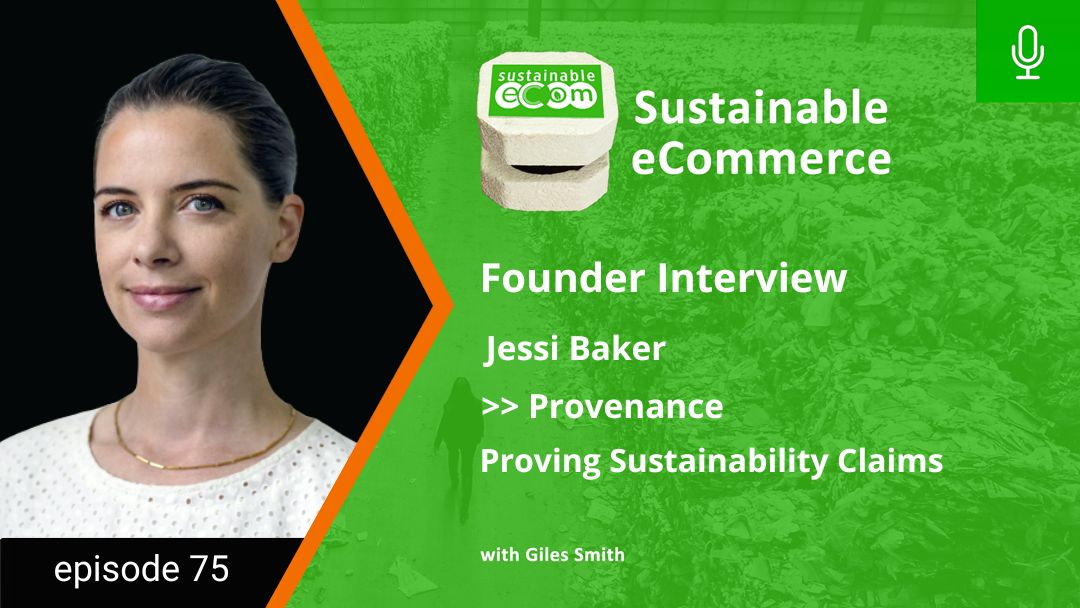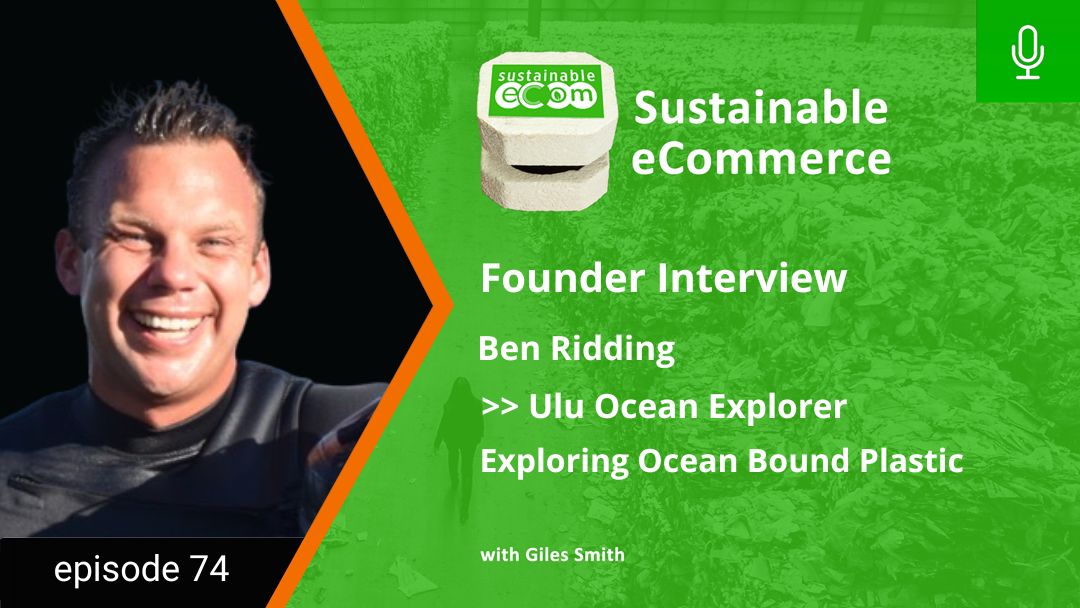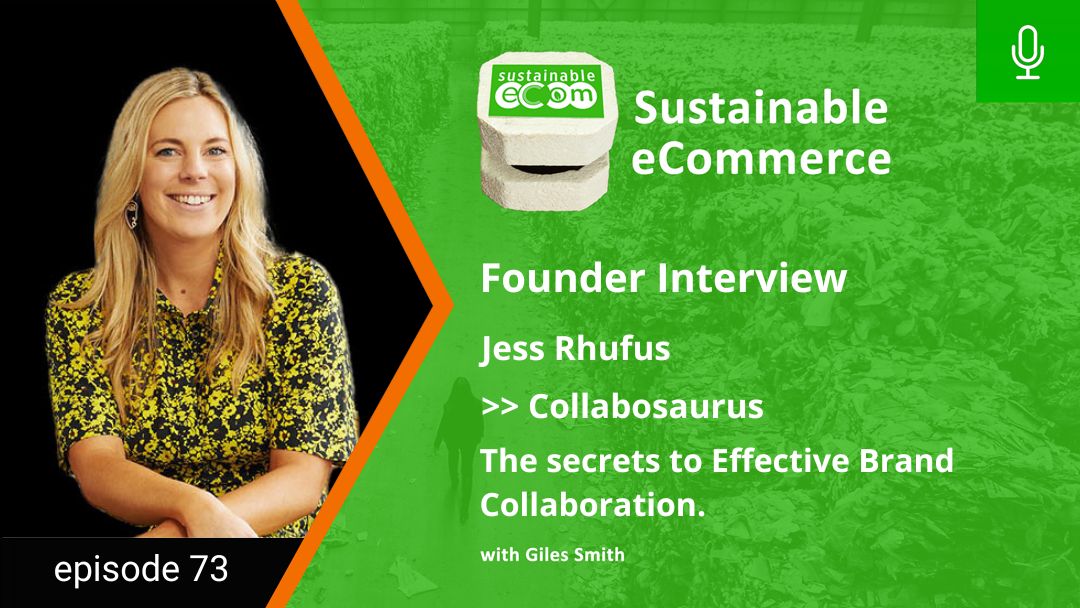Welcome to Episode 14 Of the Sustainable eCommerce Podcast!
Today I’m sharing 20 tips on how you can make your ecommerce brand more sustainable.
No matter what your political party preference was, its extremely clear that Australians voted for candidates with strong climate action policies. It was interesting seeing that, because for a couple of years now, we’ve seen report after report suggesting that 70% + of consumers are actively purchasing greener products, and seeking more environmentally friendly brands to buy them from.
So, with that very clear market signal in mind, I thought it would be helpful to cram as many tips as I have to hand into one show, and give you plenty of ideas on how your brand can become more Sustainable.
If you’re just getting started out with doing things more sustainably, listen to this episode all the way through, then come back and pick on one thing that seems the easiest for you to do and get started!
Introduction
We’re going to start today by talking about an area that for online brands has the biggest overall contribution to our Carbon footprint, but at the same time is kind of low hanging fruit for getting started.
According to Planetly, for ecommerce brands, the majority of our carbon footprint, up to 85% in fact, comes from what’s called ‘scope 3 emissions’. That is, from supply chain outside our organization. Of that, about 65% is actually generated by transport, distribution and packaging, in other words: order fulfilment.
Tip 1:
There are currently no truly green delivery services in Australia, but you can make the majority of your deliveries carbon neutral.
There are a heap of plugins that will allow you to calculate your delivery distance and purchase offsets, but honestly easiest thing to do, especially for urban deliveries is to use Sendle. They offer 100% carbon neutral delivery, and can handle your international deliveries as well.
If you’re currently using Australia Post, they do seem to be leveraging offsets too, though for international deliveries that’s restricted to the closest transport hub.
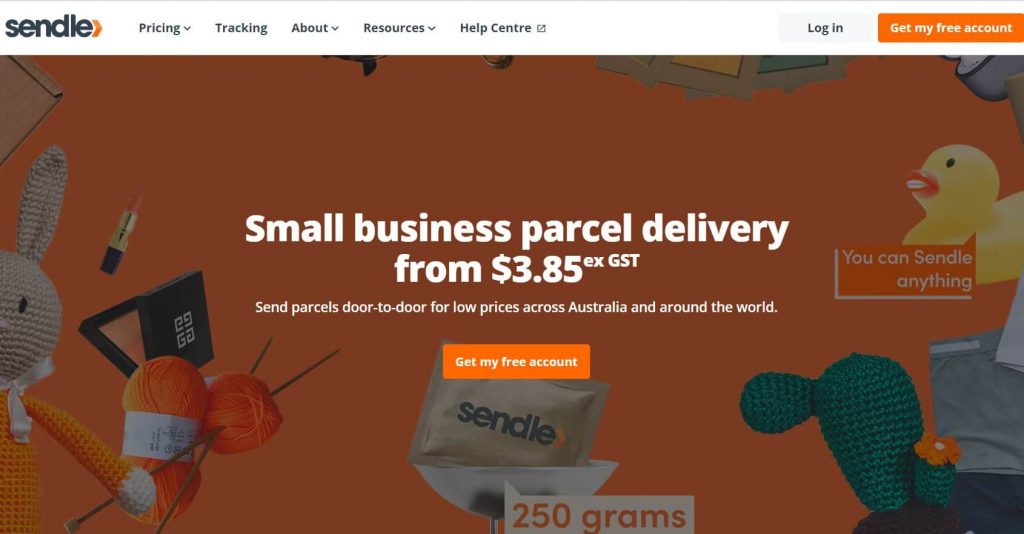
Tip 2:
Take a fresh look at your Express Shipping. Customers often want things fast, especially in the leadup to Christmas and some of the other major sales events.
Its human nature to leave things to the last minute!
The good part about that from your brand’s point of view is that customers that want Express, tend to not be as sensitive about the cost of shipping.
The major downside, from a sustainability point of view is that express shipping typically has almost triple the footprint of standard delivery, especially for inter-state orders.
Once again, Sendle handle Express. But, if you want to do more to offset the cost of faster delivery, this is where plugins like eCoCart and Cloverly can come in.
They are easy to install and configure, and allow you to purchase carbon offsets on the basis of your orders. I covered EcoCart back in episode 7, which was dedicated to explaining how to use Carbon Offsets, so check out that episode as well if you’d like to dive in a bit deeper.
Anyway, the point is here, Express shipping customers are not as price sensitive, so it could be possible to add small cost to express orders to cover the cost of offsets, without risking a negative impact on your site conversion.
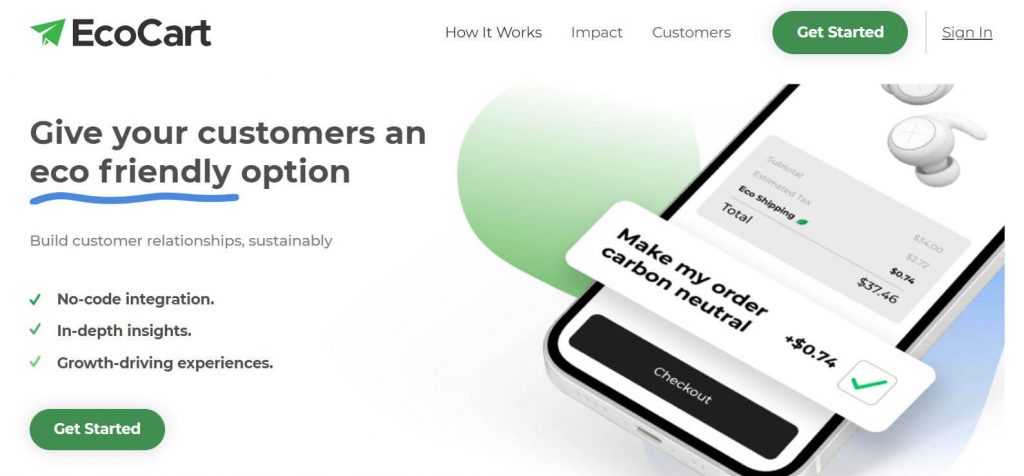
Tip 3:
Lastly in regards to shipping, it’s probably pretty clear that the impact of the shipment itself is based on how far the order has to travel between your fulfilment centre and the customer.
Carbon offsets are great, but they don’t actually reduce the emissions generation in the first place.
Once you reach a good scale as a brand, and certainly of you’re servicing international orders, its going to minimize your environmental impact to actually split your inventory and have more localised fulfilment centres.
Obviously, that has a whole host of benefits and trade-offs operationally, but the important point regards the topic of this episode is that you can materially reduce how far your orders have to travel to reach the customer.
Still on the topic of order fulfilment, its time to talk about packaging. Its been estimated that eCommerce uses about 10X as much packaging as bricks & mortar retail. I think of packaging as being a bit like an onion with layers upon layers of things to consider. I probably need to do a whole show just on that in the near future!
Tip 4:
In terms of your secondary packaging – the bits and pieces inside your presentation box – look for ways to use less!
Simplifying your packaging, having less parts and components to it can add up to big change over thousands of units. I recently purchased a replacement power cable for my laptop, and it had 17 separate pieces of packaging!
Using less packaging material reduces the resources needed, makes the packaging lighter, using less energy to ship and is less things that will end up in landfill or need energy to recycle downstream.
Tip 5:
Look for ways to use recyclable and recycled materials in your product packaging. If you’re making products that go into bottles, squeezy tubes, tubs or sachets, talk to your supplier and see if they can swap to sustainable materials, or things like recycled plastic.
With the recent turbulence in supply chains, you might find a local supplier of recycled plastic bottles can get your order fulfilled faster than a virgin plastic supplier based in China.
Even if it does cost a bit more, that might save your bacon on inventory availability in the leadup to Christmas.
Tip 6:
Of course, take the same approach to your shipment packaging, and for many you, this is truly the easiest place to start!
There are dozens of sustainable packaging suppliers now, and there’s really no need to be sending out orders with styrofoam packing peanuts, plastic air pillows or virgin wood pulp boxes of any kind.
The same goes for mailer satchels – there are quite a few packaging companies offering re-usable, compostable or even satchels made from ocean plastic, which blows my mind!
Just recently in Episode 12 we had Becs Perkasky from The Better Packaging Company on the show, and she kindly offered a 20% discount off your first order with them.
Another amazing packaging company really doing great work based here in Australia is Heaps Good Packaging, and you can get everything from them from eco satchels through to hex wrap, eco tape and even eco stickers.
In the interests of transparency, I recently became in investor and shareholder in Heaps Good, so big shout out to Ace Reunis and the team there.
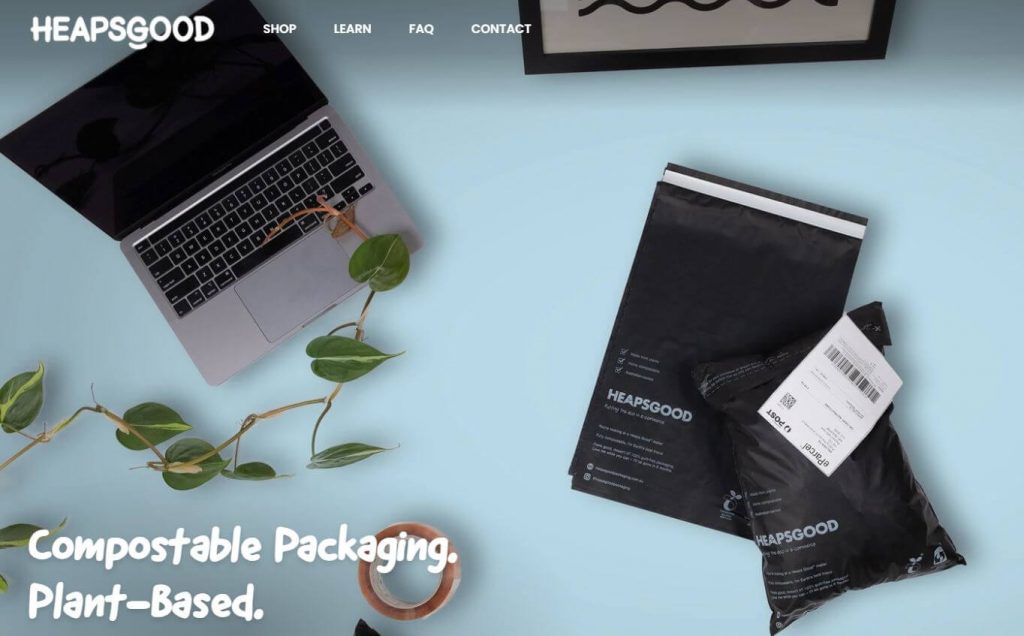
Now, a fact of life for many online brands is handling returns. That’s especially true for online fashion, and multiplied tenfold if your brand has expanded onto sales channels like Amazon. Given that returns double the distance travelled, increase packaging and in many cases directly result in perfectly good products going to landfill due to the difficulty in preparing returned items for resale, this may be one of the biggest non-sustainable areas of your business.
Unfortunately, I don’t have a silver bullet for you here, but there are some practical steps you can look at, so here goes with 5 more tips.
Tip 7
Research has shown that nearly a third of consumers will purposely order more and simply return unwanted items when returns are offered for free. Now maybe to be competitive with other brands in your space, you do have to arrange free return shipping. But most brands don’t.
Simply allowing returns of unopened or undamaged items at the customer’s own shipping expense is usually more than sufficient to reduce return rate, and could have a significant impact on your carbon footprint as well as your bottom line.
Tip 8
Aside from people who purposefully order things they expect to return, the majority of returns, and indeed straight refund for that matter are due to items simply not being what the customer expected.
Simply putting some more work into your product descriptions will help, but taking a fresh look at your product images is probably the single best way to head off unnecessary returns before they even happen.
The two most important image types to consider here are factual images (that show exactly what the product looks like, how big it is, the colour, fabric, pattern etc), and functional – how it works, what it will look like when worn, etc.
Short videos that show the product in use can be almost eye-wateringly effective at reducing your returns, eye watering in the sense that you’ll cry wishing you’d made them sooner.
Tip 9
Reducing returns doesn’t have to be about having a single policy for all your products. Shopify Plugin 8returns allows you to set custom return rules for different things, gives you advanced analytics on what is being returned & why and best of all, enables carbon offsets for the return shipment.
Tip 10
If items do get returned, one of the many considerations is what to do with those. Again, especially true if you’re working with 3rd party sales channels, but its a tricky subject even for fulfilment partners from your own online store.
There is a hugely growing trend towards brands offering after sale and second-hand marketplaces as part of the circular economy. It seems like just about every fashion & clothing retailer is doing it, from Patagonia’s famous worn wear initiative to through to Lululemon Like New.
Rather than Ditching it, can you resell the item, and even leverage that into longer and more engaged customer relationships?
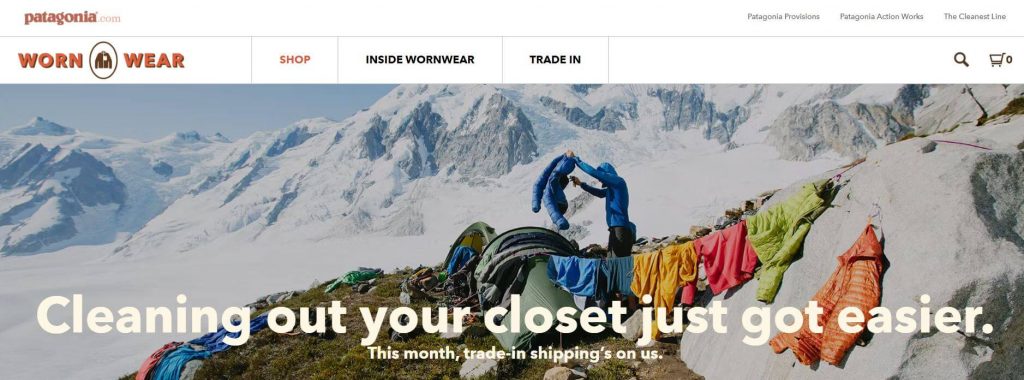
Tip 11:
Even if you can’t resell, rather than sending to landfill, there are some great recycling partners you can work with, which is essential if your product is made from multiple materials. Two great ones which some of my coaching clients use include Upparel for clothing and fabrics, and Terracycle for well, pretty much anything else.
For the next 4 tips, I want to turn our attention now to marketing, and specifically your digital carbon footprint. As dominantly digital businesses, digital marketing is utterly critical to our business model, but data transfer requires power, and where’s there’s power, there’s a footprint.
In the context of being more sustainable, I’m going to give you some tips to how to manage that down – but happy news – all of the tips in this area will actually improve your marketing performance as well.
Starting with email, I actually covered off email carbon footprint in more detail in episodes 3 & 5 of the show, but I want highlight 2 things here too. Estimates indicate that every single email you send ends up generating between 2g and 50g of Carbon. Emails at the top end of that range include attachments, and heavy use of images.
When you’re sending emails to many thousands of people on your list, all at once, and many times a year, that really adds up.
Indeed earlier this year we did an impact assessment on a medium sized ecommerce brand and discovered that their digital carbon footprint from email alone was over 1000 Tonnes of CO2 in just one year.
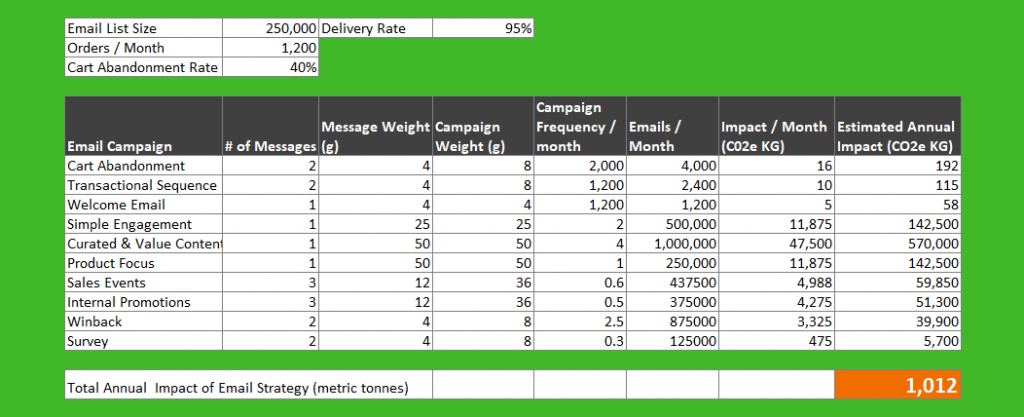
If you would like to access our FREE email carbon estimator, click here.
Tip 12:
Simply be more thoughtful about how you’re using images in your emails.
Where you do choose to use them, and there are lots of reasons why you would, crop them and compress them as much as possible.
Never use just the raw images from your phone or photo shoot in your newsletters or promotions. Even photos taken on your iPhone can regularly top out over 3MB, yet cropped and compressed could be as little as 50k, which is an 85% reduction in data, on one image, in one email to one recipient!
Tip 13:
Following on from that, the lion’s share of the carbon footprint from email marketing occurs whether the recipient opens your email or not! Many brands sent mass-mailouts to everyone on their list. If 40% of your list doesn’t even open your emails, that’s a lot of carbon wasted! Tip 13 then is that segmenting your list, and regularly pruning it to remove inactive subscribers is the fastest way to reduce your carbon footprint – and it also has a nice long term benefit of maintaining deliverability and improving open rates.
Tip 14:
Not all communications channels are equal. Email uses internet protocol to send data (your email) to subscribers, but SMS uses old school telephony. As a result, you can send somewhere between 350 and 2000 sms messages for the same carbon impact as a single email.
With higher open rates, and potentially also higher click through rates than emails, it makes sense to leverage SMS for time-sensitive promotions and offer alerts and you’ll be reducing your carbon impact at the same time.
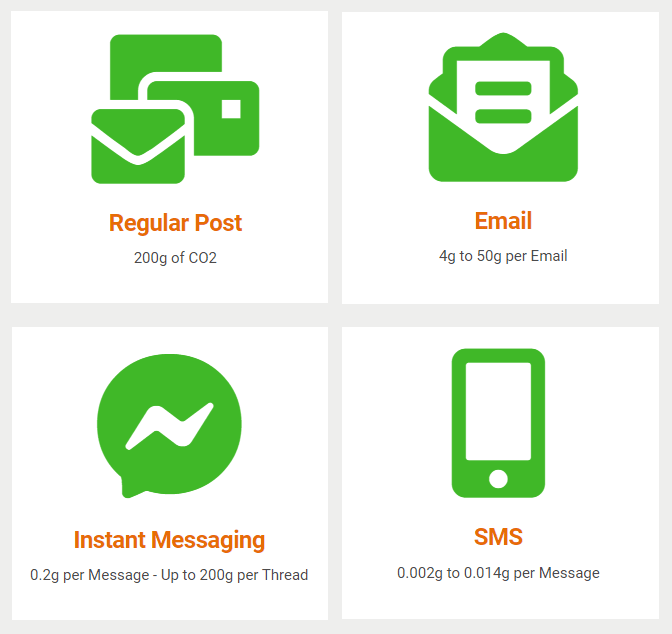
Tip 15:
For Tip 15, we move over to look at your online shop. Obviously people browsing your store are also downloading data. There’s text, images, html code, stylesheets, plugin code and all manner of other data, all of which takes time to load and yes, once again has a carbon footprint.
Much like email, one great way to minimize your impact here is to take simple steps to compress your images, remove unused apps, and have your developer minimize the code as much as posssibe. Aside from pure carbon reduction, that’s going to speed up your load times, which will help with site conversion and SEO too.
Tip 16:
If you’re on Shopify – good news, Shopify already generates Carbon offsets for all stores in its data centres.
If you’re hosted on wordpress, rather going through a complicated exercise to offset the right amount, instead consider moving to hosting service that uses green energy like Austiger.
Tip 17:
While we’re on the topic of moving to green energy, why not transition your warehouse and office to using green energy too?
Tip 17 is to take inspiration from NZ-based sustainable footwear brand All Birds and make a commitment to transitioning to green energy for all our plant, property and equipment by 2025.
For the final 3 tips to round out the 20, I wanted to go a bit big picture and look at 3 software platforms that will help you in the context of sustainability in the future.
Tip 18:
For tip 18, as we’ve seen from this long yet still whistlestop tour of sustainability in eCommerce, there’s a lot to think about.
If you’re serious about making sure your brand is on a great pathway to sustainable operations and being transparent with your customers about your impact, then Planetly has built a brilliant platform that makes carbon management easy, right across your operations.
Tip 19:
When your thoughts inevitably turn to making sustainable products or using sustainable materials, then you’ll need a cost effective way to measure that and provide transparent information about the product’s impact to your customers.
For under $100 per product, you can get a product sustainability assessment done, using state of the art technology, using the Dayrize system.
I interviewed Austin Simms from Dayrize in Episode 11, and I do recommend you check that out, because I was totally blown away by how game changing their platform is.
It’s the fastest and cheapest way to prove the sustainability of your products to customers, as well as get clear guidance on how to make existing products more sustainable.
Tip 20:
Finally and at long last, it’s time to get rewarded for all your hard work on your sustainability journey.
There’s a new app platform launching in Australia this year that promises to connect environmentally conscious consumers with sustainable brands.
It’s called Greener, and it looks promising to bring you just the sort of customers that are likely to love your products and your brand.
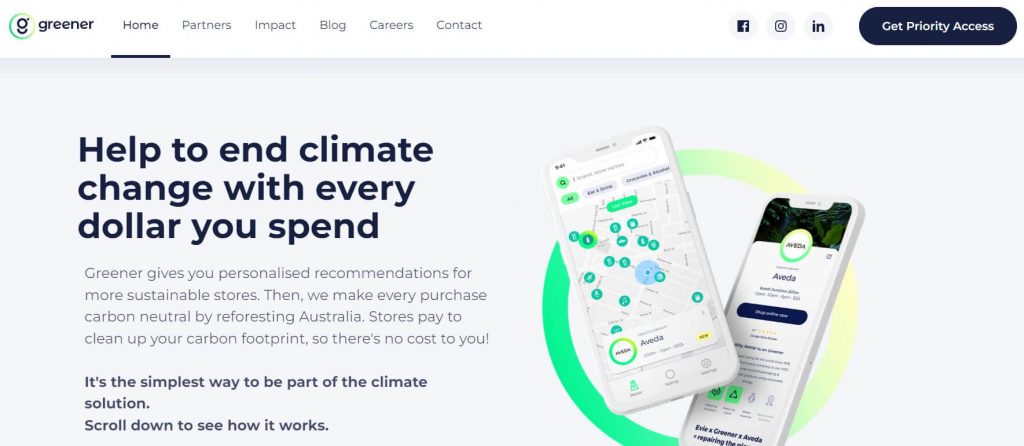
That’s it – phew! 20 tips completed on how to make your ecommerce brand more sustainable. If you’re listening on a podcast network, make sure you tap the link in the episode description and come through to the main episode page, because I’ll be putting links in there to all resources and tools that I’ve mentioned today.
I know there’s a lot in this episode, and if you’re just getting started out, my advice is to just pick one thing you think you can get done quickly, and take action to make that happen.





